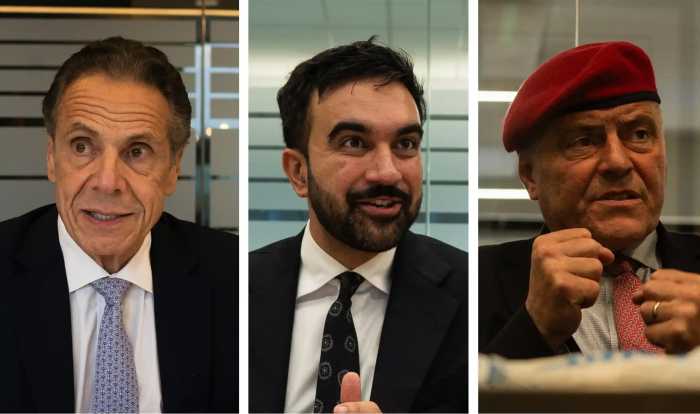A blue-ribbon panel of architects, designers and AIDS activists is conducting a competition for an AIDS memorial in the planned triangle park across from the former St. Vincent’s Hospital campus in Greenwich Village.
Michael Arad, who won the design competition for the national 9/11 Memorial at the former World Trade Center site, will head a jury soliciting and judging designs for an AIDS memorial in the park. A park at the site is mandated as part of Rudin Management’s residential redevelopment of the St. Vincent’s site.
Richard Meier, architect of the Getty Center in Los Angeles, museums in Barcelona and Frankfurt and the Westbeth artists residence in the West Village, is another member of the panel.
Elizabeth Diller, a Princeton architecture professor and a member of the firm designing the High Line park, is also on the panel, along with Robert Hammond, co-founder of Friends of the High Line.
Barry Bergdoll, architecture and design curator at the Museum of Modern Art; Marjorie Hill, chief executive officer of Gay Men’s Health Crisis; Ken Smith, a landscape architect; Suzanne Stephens, deputy editor of Architectural Record: choreographer Bill T. Jones; and Kurt Andersen, the journalist and novelist, complete the jury.
The AIDS Memorial Park Steering Committee, organized by members of the Queer History Alliance, the competition’s sponsor, is hoping for a redesign of the park, which is currently included in the city ULURP (Uniform Land Use Review Procedure) review of Rudin’s proposed 450-apartment project on the east side of Seventh Avenue.
The current design proposed by Rudin is for a triangular park bounded by 12th Street and Seventh and Greenwich Avenues. An existing 10,000-square-foot, underground space beneath the Seventh Avenue side of the triangle would be eliminated to allow the proposed park to be at sidewalk level. In connection with the residential redevelopment on the east side of the avenue, Rudin is contributing $10 million to build the park on the west side of the avenue.
The existing triangle, not publicly accessible, is about four feet above sidewalk level because of the existing underground space that formerly served a materials-handling facility for the now-shuttered hospital. The current design calls for removal of both the materials-handling building and a storage area for oxygen tanks.
Michael Seltzer, chairperson of the AIDS Memorial Park Steering Committee, told the City Planning Commission last week that several Village organizations have signed on in support of the AIDS Memorial with the underground space preserved as a teaching and community meeting center.
Service institutions, including VillageCare, Greenwich House, Housing Works and Congregation Beit Simchat Torah, and neighborhood organizations, including the Lower 13th Street Block Association and the Lower Fifth Avenue Block Association, are backers of the AIDS Memorial, Seltzer said. Among those that also endorse the proposal are Gay Men’s Heath Crisis, the LGBT Community Center, the Stonewall Community Foundation, Bailey House and amFAR (Foundation for AIDS Research).
“In my outreach to my neighbors, a number have expressed how there is a shortage of community meeting space,” Seltzer said. “For example, Christine Conroy, a founder and director of Music Give Life and its senior citizen preforming group, The Show Stoppers, shared with me how the group needs space for evening rehearsals.
“That’s just one example of how the proposed 10,000-square-foot learning center and community gathering place can serve our neighborhood,” he said.
The November 30 City Planning hearing was the midpoint in the review of Rudin’s residential project and the triangle across the avenue. Borough President Scott Stringer acknowledged at the hearing that the AIDS Memorial Park plan was “not only a an appropriate but a laudable endeavor to find a way to commemorate those who have been lost to, those who lived through, and those who continue to live with the epidemic.” But Stringer stopped short of making the AIDS Memorial Park a condition of his approval of the Rudin project.
“Unfortunately, proposals to introduce a new use on the triangle site or to significantly redesign the park after the design process will require the modification of the special permit in a follow-up action,” Stringer noted in his testimony.



































